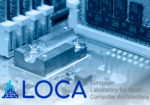The IBM-led OpenPOWER Foundation announced the contribution of the IBM A2I POWER processor core design and associated FPGA environment to the open source ecosystem. The release, which took place today at the Linux Foundation Open Source Summit, follows the opening of the POWER Instruction Set Architecture (ISA) last August and is intended to enable the […]
Video: Open and High Performance Computing
Hugh Blemings from the OpenPOWER Foundation gave this talk at the Linux.Conf.au conference. “This session will explain the importance of open hardware and software at all levels of the compute environment – embedded/IoT to desktop to hyperscale systems. From here a brief introduction to OpenPOWER and the OpenPOWER Foundation as well as an update on the ecosystem, the status of the hardware and software stacks in question as well as an overview of some of the OpenPOWER hardware out there.”
IBM Opens POWER Instruction Set Architecture
This week at The Linux Foundation Open Source Summit, IBM announced it is opening the POWER Instruction Set Architecture (ISA). “The opening of the Power ISA, an architecture with a long and distinguished history, will help the open hardware movement continue to gain momentum,” said Mateo Valero, Director of Barcelona Supercomputing Center. “BSC, which has collaborated with IBM for more than two decades, is excited that IBM’s announcements today provide additional options to initiatives pursuing innovative new processor and accelerator development with freedom of action.”
Calista Redmond named CEO of RISC-V Foundation
Today the RISC-V Foundation announced that Calista Redmond has been appointed Chief Executive Officer (CEO), effective immediately. I’ve always understood the potential short- and long-term impact of the RISC-V license-free ISA on the open source community. Having spent a lot of my career working in the open source ecosystem, I’m excited to help RISC-V grow and deliver on the Foundation’s mission of paving the way for the next 50 years of computing design and innovation,” said Redmond, CEO of the RISC-V Foundation.”
Radio Free HPC runs down the latest TOP500 Fastest Supercomputers
In this podcast, the Radio Free HPC team reviews the latest TOP500 list of the world’s fastest supercomputers. “The TOP500 celebrates its 25th anniversary with a major shakeup at the top of the list. For the first time since November 2012, the US claims the most powerful supercomputer in the world, leading a significant turnover in which four of the five top systems were either new or substantially upgraded.”
Minsky at Murex: GPUs for Risk Management
Pierre Spatz from Murex gave this talk at the NVIDIA GPU Technology Conference. “Murex has been an early adopters of GPU for pricing and risk management of complex financial options. GPU adoption has generated performance boost of its software while reducing its usage cost. Each new generation of GPU has also shown the importance of the necessary reshaping of the architecture of the software using its GPU accelerated analytics. Minsky featuring far better GPU memory bandwidth and GPU-CPU interconnect rase the bar even further. Murex will show how it has handled this new challenge for its business.”
ScyllaDB Announces Support for IBM Power Systems for Real Time Big Data
Today real-time database company ScyllaDB announced a new Scylla Enterprise release with optimizations for IBM Power System Servers with the IBM POWER9 multi-core architecture. By combining Scylla’s highly performant, close-to-the-hardware design with next-generation IBM Power System Servers, organizations can reach new levels of performance while also reducing the footprint, cost and complexity of their systems. “ScyllaDB has designed a powerful distributed database that extends the performance advantages we’ve introduced with our multi-core POWER9 processors,” said Tim Vincent, IBM Fellow and Vice President of IBM Cognitive Systems. “The combination of the Scylla NoSQL database and our Power System Servers enables our shared customers to scale up their systems rather than continually scaling out, creating new opportunities for data center consolidation and price performance.”
Brain Research: A Pathfinder for Future HPC
Dirk Pleiter from the Jülich Supercomputing Centre gave this talk at the NVIDIA GPU Technology Conference. “One of the biggest and most exiting scientific challenge requiring HPC is to decode the human brain. Many of the research topics in this field require scalable compute resources or the use of advance data analytics methods (including deep learning) for processing extreme scale data volumes. GPUs are a key enabling technology and we will thus focus on the opportunities for using these for computing, data analytics and visualization. GPU-accelerated servers based on POWER processors are here of particular interest due to the tight integration of CPU and GPU using NVLink and the enhanced data transport capabilities.”
Pre-exascale Architectures: OpenPOWER Performance and Usability Assessment for French Scientific Community
Gabriel Hautreux from GENCI gave this talk at the NVIDIA GPU Technology Conference. “The talk will present the OpenPOWER platform bought by GENCI and provided to the scientific community. Then, it will present the first results obtained on the platform for a set of about 15 applications using all the solutions provided to the users (CUDA,OpenACC,OpenMP,…). Finally, a presentation about one specific application will be made regarding its porting effort and techniques used for GPUs with both OpenACC and OpenMP.”













